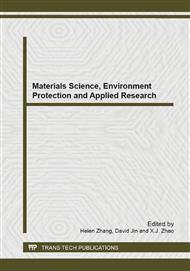p.141
p.145
p.155
p.159
p.163
p.167
p.171
p.175
p.179
Study on the Conditions of Oxidation of Nitrogen Dioxide and Nitrite by Manganese Dioxide
Abstract:
The conditions of oxidation of nitrite by manganese dioxide in the solution was studied, with sodium nitrite was used as the sample, respectively. Experiment results showed that the stronger oxidation to nitrite in strong acid, but nitrous acid is instable, escaping NO2 out from the solution. When pH=3.5, the oxidation rate of nitrite with manganese dioxide was better. The concentration of nitrite tended forward to be stable after 30min. After reaction, the oxidizing power of manganese dioxide which was treated by dilute sulfuric acid wasn't enhanced. The manganese dioxide treated by acid reacted with fresh nitrite solution and the effect wasn't good. The process of oxidation could be go on and the concentration of nitrite would decrease obviously when fresh manganese dioxide used to react the same original nitrite. Maybe some active sites exist at the surface of manganese dioxide. When the reaction equilibrium was reached, the active point at the surface of manganese dioxide would probably have disappeared. The property of oxidation of manganese dioxide to nitrite could be used in treat NO2 and nitrite. Combining the two methods which absorption of NO2 by base and oxidation of NO2 or nitrite by manganese dioxide, NO2 would be treated completely and treatment cost would be lower.
Info:
Periodical:
Pages:
163-166
Citation:
Online since:
March 2014
Authors:
Keywords:
Price:
Сopyright:
© 2014 Trans Tech Publications Ltd. All Rights Reserved
Share:
Citation:


